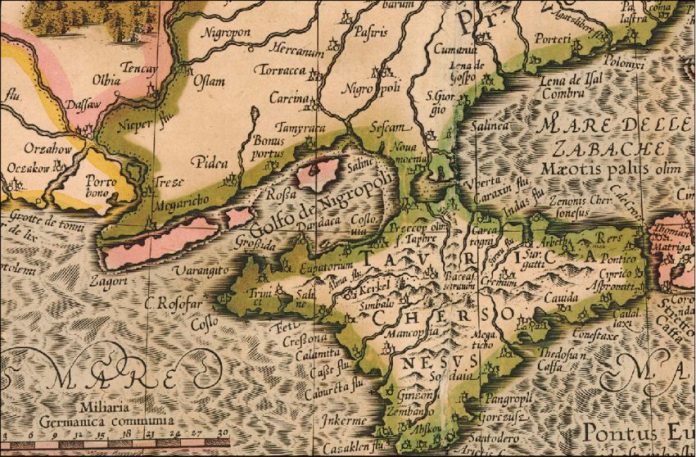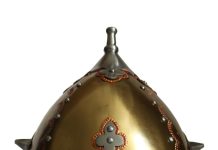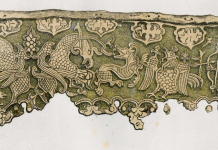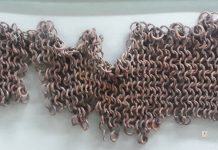Edward Daniel Clarke (1769-1822) wrote in his famous book ‘Travels in Russia‘ which became a bestseller in 19th-century Europe that he had with him the Geography of Strabo which turned out to be extremely helpful in his exploration of the legendary peninsular. Strabo (64 BC – c. 24 AD) was a Greek geographer, philosopher, and historian who lived in Asia Minor during the transitional period of the Roman Republic into the Roman Empire. Below are some examples from the Edward Clarke’s book:
Strabo describes all the country between Theodosia (Caffa) and Panticapseum (Kertchy) as rich in corn and full of inhabitants… In the last stage from Kertchy to Caffa, we passed the third, what is today the outer vallum or boundary of the Bosphorians, which separated their peninsula from the country of Tauri. Its remains, as well as those of the towers placed thereon, were very visible. ‘his wall extends from the Sea of Azof, beginning eastward of a place now called Arabat, to the mountains behind Caffa; it is mentioned by Strabo, who states from Hypsicrates, that it was constructed by Asander, 360 stadia in length, having at every stadium a turret, This description agrees with its present appearance; the distance from the Sea of Azof is not so great, but the oblique direction of the wall makes its length equal to that which Strabo has given.
The great bay of Aktiar [Sevastopol Bay currently] also bears the name of ‘The Roads; and here the Russian fleet is frequently at anchor. It is the Ctenus of Strabo… The country included within the isthmus formed by the principal harbour of Aktiar, or Inkerman, that is to say, by Ctenus of Strabo, and the port of Balaclava, or Portus Symbolorum, is the Heracleotic Chersonesus accurately described by that author as a portion of the Peninsula Major, or Taurica Chersonesus. On this small district stood the cities of the old and new Chersonesus, and Eupatorium; the temple of Diana, the Promontory Parthenium, celebrated by the story of Iphigenia: the famous Chersonesian Mole: with numerous ramparts, tombs, canals, and other works, the memory of which historians preserve, but the last trace of whose magnificence the Russians daily labour to annihilate…
After returning from our excursion to Inkerman, we endeavoured to investigate the ancient geography of the Heracleotic Peninsula. It was a work of some difficulty; yet the materials indeed were ample. The ruins, as they still existed, with the assistance of Strabo, and an accurate survey of the country, might be deemed sufficient for the purpose; but the insurmountable difficulties created by the barbarity of the Russians were very intimidating.
Then arriving upon the bay for quarantine, on its western side appeared the ruins and sepulchres of a town perfectly distinct from that of Chersonesus, and which answers the situation assigned by Strabo to Eupatorium, built by Diophantus. His observations state, that the promontory on which the town stood, inclining towards the city, at the distance of fifteen stadia, formed a considerable bay, beyond which was the Ctenus, and that the inhabitants built.a mole across, which united the two towns. The remains of the mole are yet visible, and the distance, allowing for every stadium an English furlong, is precisely that which he describes.
In this city, says Strabo, is the temple of a virgin, a certain demon, from whom also the promontory is named, a hundred stadia farther on, and called Parthenium, having the fane of the demon, and her image. Between the city and the promontory are three ports. Taking therefore this clue, and following the coast, the three harbours mentioned by Strabo will be found to occur very regularly…
The monks of the monastery, in the ground behind their chapel, had recently found a small stone column, the shaft of which was seven feet eight inches and a half in length, and thirteen inches in diameter. This column, together with a few broken slabs of marble, and other antiquities discovered there, seem to prove, supposing Formaleoni’s position of Parthenium to be correct, that in this situation stood the o/d Chersonesus, which Strabo, after speaking of the new, describes as in ruins and as occurring after the promontory.
Nothing can equal the fidelity with which Strabo has laid down the coasts of the Crimea—a circumstance which may perhaps be attributed to the place of his nativity, Amasia [situated on the southern shore of the Black Sea], whose situation enabled him to acquire a familiar knowledge of the shores of the Euxine [Black Sea]. In his account of the Archipelago [Aegean Islands] and Mediterranean, although always an accurate writer, he by no means evinces the same degree of precision. According to him, the port of Balaclava, together with the Ctenus, or harbour of Inkerman, constituted by their approach an isthmus of forty stadia, or five miles; which, with a wall, fenced in the minor peninsula, having within it the city of Chersoneus. The wall we found afterwards with Professor Pallas, and its extent agreed very well with Strabo’s account.
From this village to Aloupka, still proceeding by a narrow undulating and devious track among the rocks, at a considerable elevation above the sea, we enjoyed a prospect of the boldest scenery which can be found in the Crimea. Immediately before us we beheld the stupendous Criu-Metopon [Sarych], mentioned by Strabo and other ancient geographers; this projecting into the bosom of the deep, together with the opposite promontory of Caramde, upon the coast of Puphlagonia divides the Black Sea into two parts, so that vessels sailing between the two capes can discern the land on either side…
It is worthy of note, as we shall soon show, that a promontory and village bearing at this day the name of Parthenit, evidently corrupted from Parthenium, is found to the eastward of the Criu-metopon, in the vicinity of Aloupka. Thus, while Strabo and Ovid place the promontory of Parthenium in the Heracleotic Chersonesus, other circumstances seem to fix its situation near the most southern point of the Crimea;
High above all are the lofty and rugged summit of those mountains which give such a decided character to the southern coast of the Crimea, that no geographer has neglected to notice them. Strabo forcibly describes their situation and nature.
From this place we had a fine view of the mountain Tchetiragh [Ai Petri], the Trapesus of Strabo, whose lefty summit appeared above a range of clouds which veiled all the lower part. Its perpendicular height does not exceed 1400 feet; but it rises 80 rapidly from the coast about Alusta, that its seeming altitude is much greater.
At the distance of Abuat two miles from Balaclava, as we proceeded to that place, we discovered the traces of an ancient wall, extending from the mountains eastward of the harbour towards the west, and thus closing the approach to Balaclava on the land side. As it offered a clue to the discovery of the other wall mentioned by Strabo, which extended across the isthmus from the Ctenug to the Portus Symbolorum, we determined to pursue it, and continued on horseback, guided by its remains…
The distance between the ports is very erroneously stated, and exaggerated, in all our maps. It agrees precisely with Strabo’s measurement of forty stadia, or five miles from sea to sea.
The Parthenium of Strabo was within the Heracleotic Cheresonesus, as the plain text of that author undoubtedly demonstrates; and if there be a spot well calculated for the terrible rites said to have been celebrated in honour of the Taurican Diana, as well as for the consonance of its position with the distance Strabo lias assigned it from the city of Chersonesus, it is the Sacred Promontory.
Strabo, with that extraordinary accuracy which characterizes every page of his writings that relate to the Crimea, states the breadth of the isthmus as equal to forty stadia; and it is, as has been stated, more than five miles, which would exactly accord with his description.
Read about Taurician Diana and her real name >
“Cradle of Civilizations” book has more insights into the history of Taurica and the reason for the Taurians’ cruelty towards the Greeks.










